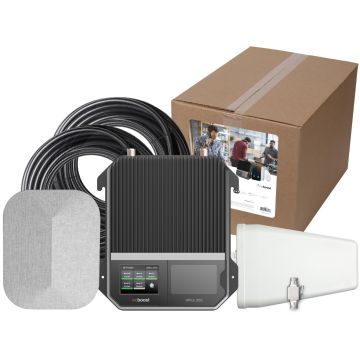
The Complete Guide to 5G
By Courtney on
5G, or fifth-generation wireless technology, is the latest and greatest in mobile communication. As the successor to 4G LTE, it promises faster speeds, lower latency, and a more efficient network to support our ever-growing reliance on mobile devices. With the ability to connect more devices simultaneously and provide a seamless experience, 5G is set to revolutionize the way we communicate, work, and play.
Why understanding 5G matters
You might be wondering why all the hype around 5G? Well, it's not just about faster download speeds for your smartphone. As more and more devices become interconnected, 5G will play a crucial role in transforming industries, from healthcare to transportation, and even how we build our cities. That's why it's essential to understand what 5G is, how it differs from 4G, and the impact it will have on our lives in the near future. So, buckle up and get ready for a deep dive into the world of 5G!
5G vs. 4G

Speed and capacity differences
One of the most significant differences between 5G and 4G is, of course, speed. 5G is expected to be up to 100 times faster than 4G, with download speeds reaching up to 10 gigabits per second. Some companies, like Nokia, have even reported testing 5G at speeds of 30 gigabits per second! But it's not just about speed; 5G also has the capacity to handle more connections at once, making it perfect for supporting the growing number of internet-connected devices we use daily.
Latency improvements
Another key improvement of 5G over 4G is its lower latency. Latency, or the time it takes for data to travel between devices, is crucial for real-time applications like video calls or online gaming. With 5G, latency is expected to be significantly reduced, making these experiences even more seamless and enjoyable.
Network architecture and infrastructure
The architecture of 5G networks is quite different from that of 4G. For starters, 5G relies on a combination of technologies like Massive MIMO and small cells, which improve coverage and capacity. This also means that the infrastructure for 5G will require more antennas, placed closer together than the traditional cell towers used for 4G. Furthermore, 5G-enabled devices will need different antennas and are expected to consume less power, meaning longer battery life for your phone.
Real-world performance
It's important to note that while 5G promises impressive speeds and improvements, real-world performance may not always match up. Factors like tall buildings, trees, and your distance from a cell tower can impact the quality of your 5G signal. Nonetheless, as 5G networks continue to expand and evolve, we can expect better coverage and more consistent performance over time.
Evolution of mobile networks

Brief history of 1G to 4G
Let's take a quick trip down memory lane, shall we?
- The first generation of mobile networks, or 1G, emerged back in 1982.
- Fast forward to 1991, and we had 2G networks that brought along digital voice and SMS features.
- In 2001, 3G networks arrived, providing us with mobile internet and video calls.
- Finally, 4G made its entrance around 2009, delivering faster data speeds and supporting a wide range of data-intensive applications.
It's amazing how far we've come, right?
The role of ITU and 3GPP
When it comes to setting standards for mobile networks, two organizations play a significant role: the International Telecommunication Union (ITU) and the 3rd Generation Partnership Project (3GPP). These international governing bodies define the specifications and performance criteria for each generation of mobile technology. Sometimes, they even set standards retroactively, like with 4G. Not all marketed 4G networks actually met the ITU and 3GPP standards; only specific versions of 4G LTE were up to par. It's thanks to these organizations that we have a clear understanding of what to expect from our mobile networks, including the exciting world of 5G.
Speed and performance of 5G

Expected speed improvements
Download and upload speeds
So, you're probably wondering, how fast will 5G actually be? Well, experts predict that 5G could be 10 to 100 times faster than 4G, with download speeds of up to 10 gigabits per second. Some companies, like Nokia, have even tested 5G speeds at a jaw-dropping 30 gigabits per second! That's a whopping 1,000 times faster than 4G. Can you imagine downloading an entire HD movie in just moments? That's the kind of speed we're talking about here.
Real-world factors affecting speed
But, hold on a second. As exciting as these numbers are, it's essential to remember that real-world factors might affect your actual 5G experience. Things like tall buildings, trees, and your distance from a cell tower could slow down your signal. So, while 5G is undoubtedly a game-changer, it's essential to manage expectations and understand that real-world speeds may not always match the hype.
Reduced latency
Another fantastic aspect of 5G is the significantly reduced latency, or lag, compared to 4G. This improvement means that data will travel much faster between devices, making activities like online gaming and video conferencing smoother than ever. It's all about getting that instant response, right?
Capacity and network efficiency
Besides speed and reduced latency, 5G will also bring better capacity and network efficiency. Remember our earlier analogy of 4G being like a door and 5G being a gigantic hallway? With 5G, we'll see a massive boost in the number of devices that can connect to the network simultaneously without getting clogged up. This improvement will be great for internet-enabled devices like smart appliances, and it'll pave the way for innovations like robotic surgery, self-driving cars, and delivery drones. The future is looking bright, my friend!
Applications and use cases for 5G

Internet of Things (IoT)
With 5G on the scene, the Internet of Things (IoT) will really come into its own. We're talking about smart refrigerators that can order groceries for you, coffee pots that start brewing as soon as your alarm goes off, and so much more. The increased capacity and efficiency of 5G networks will make it easier for these devices to stay connected and work seamlessly together. It's like your entire home is getting an upgrade!
Robotic surgery
Robotic surgery is already pretty impressive, but with 5G, it could reach new heights. The reduced latency and improved speed will allow doctors to perform highly precise, remote surgical procedures in real-time. Imagine being able to access the best surgeons in the world, no matter where you live. That's the kind of potential 5G brings to the table in the medical field.
Autonomous vehicles and drones
Self-driving cars and delivery drones are already making their way into our daily lives, but 5G will supercharge their efficiency and capabilities. With faster communication between vehicles and infrastructure, we can expect more reliable and safer autonomous transportation. Plus, drones will be able to deliver packages quicker and more accurately, making online shopping even more convenient. Talk about a win-win!
Smart cities and infrastructure
Last but not least, 5G will play a huge role in transforming our cities and infrastructure into "smart" ecosystems. We're talking about smart traffic management systems that can reduce congestion, intelligent street lighting that conserves energy, and real-time monitoring of public utilities to save resources. With 5G, our cities will become more connected, efficient, and environmentally friendly. The future is looking smarter already!
5G infrastructure

Small cells and antennas
Get ready for some changes in our urban landscapes, because 5G infrastructure is going to look a bit different from what we're used to. Instead of the massive cell towers we have now, 5G will rely on small cells and antennas placed much closer together. These small antennas will be discreetly installed on streetlights, rooftops, and other urban fixtures to ensure a strong, reliable signal. It might take some getting used to, but it's all in the name of faster, more efficient connectivity.
Changes to device hardware
Your phone is about to get a makeover, too! In order to fully benefit from 5G, devices will need to be equipped with new antennas designed specifically for the latest network technology. Don't worry, though – these changes will be happening behind the scenes, so your phone will still look as sleek as ever. Plus, manufacturers are working hard to ensure that 5G devices remain compatible with 4G networks, so you won't be left in the dark if you're not quite ready to make the jump.
Power efficiency and battery life
Here's some great news for all of us who are constantly charging our phones: 5G is expected to be much more power-efficient, meaning longer battery life for our devices. The improved efficiency of 5G networks will allow devices to transmit and receive data faster and with less power consumption, giving your battery a much-needed break. So, not only will you be able to enjoy lightning-fast connectivity, but you'll also be able to spend less time tethered to a charging cable. Talk about a game-changer!
Major carriers and their 5G offerings
AT&T
When it comes to AT&T's 5G, there's been a bit of confusion. Remember AT&T's "5G Evolution"? Well, it turns out that was actually just an advanced form of 4G LTE, not true 5G. Nevertheless, AT&T has since rolled out its true 5G network, offering faster speeds and improved connectivity for customers with compatible devices. Just make sure to double-check coverage maps, as 5G availability still varies by location.
Verizon
Verizon has been hard at work testing and rolling out its 5G network. While there was some initial uncertainty about whether their technology was a true step up from 4G LTE, they've since proven themselves as a major player in the 5G game. Verizon's 5G Ultra Wideband network is known for its lightning-fast speeds and has been expanding its coverage to reach more customers. Just remember, you'll need a 5G-capable device to take advantage of all that speed!
T-Mobile
T-Mobile has been making some serious strides in the 5G world. They've built a nationwide 5G network that's available in many locations, providing faster download and upload speeds to customers with compatible devices. T-Mobile's 5G coverage is constantly growing, so if you're not already in a covered area, there's a good chance you will be soon.
Sprint (merged with T-Mobile)
Sprint and T-Mobile joined forces in a merger, combining their resources and networks to create a more robust 5G experience for their customers. As a result of the merger, Sprint customers have been integrated into the T-Mobile network, giving them access to the combined 5G coverage. This collaboration has made the new T-Mobile a significant contender in the 5G race, offering a strong and ever-expanding network for its customers.
Challenges and future developments

Expanding coverage
While 5G is undoubtedly exciting, one major challenge carriers face is expanding coverage to reach more people. Since 5G requires a denser network of smaller cells and antennas, it's a significant undertaking to build the infrastructure necessary to bring the service to everyone. However, carriers are continuously working to expand their networks, so it's only a matter of time before 5G becomes more widespread.
Standardizing 5G technology
Even though 5G is already being rolled out, there's still some work to be done when it comes to standardizing the technology. International governing bodies like the ITU and 3GPP are responsible for setting the standards, and while they've made progress, there's always room for improvement. As the technology evolves, it's essential to continue refining these standards to ensure seamless integration and interoperability between different devices and networks.
Addressing potential health concerns
As with any new technology, there have been questions and concerns about the potential health impacts of 5G. Some worry about the potential effects of increased exposure to radiofrequency radiation, particularly with the denser network of antennas required for 5G. It's important to keep researching and addressing these concerns as the technology continues to advance, ensuring that 5G is both safe and effective for users.
Continued investment in infrastructure
Building a robust 5G network requires a significant investment in infrastructure, from new antennas and cells to upgraded hardware in devices. Carriers, governments, and other stakeholders must continue to invest in this infrastructure to ensure the widespread availability and success of 5G. As the technology continues to evolve, it's crucial to stay ahead of the curve and be prepared for future developments that will shape the next generation of mobile connectivity.
Conclusion
The potential impact of 5G on society
As we've discussed throughout this guide, 5G has the potential to revolutionize the way we live, work, and communicate. With its incredible speed, reduced latency, and improved network efficiency, 5G will enable a myriad of applications, from IoT devices and smart cities to autonomous vehicles and advanced healthcare. It's truly an exciting time as we watch this technology unfold and witness its impact on society.
Encouraging readers to stay informed on 5G developments
With so much happening in the world of 5G, it's essential to stay informed about the latest developments, innovations, and news. Keep an eye on your favorite tech blogs, follow industry experts on social media, and subscribe to newsletters to ensure you're up-to-date on everything related to 5G. By staying informed, you'll be better prepared to embrace the incredible potential of this next-generation technology and make the most of the opportunities it offers. The future of connectivity is here, and it's going to be an amazing ride!




